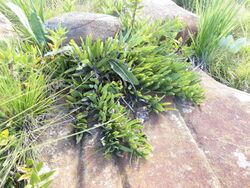Biology:Protea parvula
| Protea parvula | |
|---|---|

| |
| Scientific classification | |
| Kingdom: | Plantae |
| Clade: | Tracheophytes |
| Clade: | Angiosperms |
| Clade: | Eudicots |
| Order: | Proteales |
| Family: | Proteaceae |
| Genus: | Protea |
| Species: | P. parvula
|
| Binomial name | |
| Protea parvula Beard[2]
| |
Protea parvula, also known as the dainty sugarbush,[3][4][5] or kleinsuikerbos in Afrikaans,[citation needed] is a small flowering shrub belonging to the genus Protea.[3][5]
Taxonomy
It was first described in 1958 from Mpumalanga (then part of the former Transvaal province) by John Stanley Beard.[2]
Description
It is a low-growing, creeping, shrubby groundcover, growing only up to 16cm in height.[5]
Sources differ on the ability of this species to survive wildfires. According to one source it is long-lived, with plants surviving over a century, and can regrow after fire from an underground bole or rootstock,[3] another source states the plant is killed by fire.[5] The seeds are released by the plant as soon as the woody fruit is ripe, from April to July, and are dispersed by the wind.[3][5] The seeds are fire-proof, and simply lie on the ground until germination.[5]
Protea parvula flowers in the summer,[4] from December to March. The plant is monoecious with both sexes in each flower.[5] The flowers are pollinated by birds.[3][5]

Distribution
Protea parvula is found on the slopes of the Drakensberg Mountains, from Mariepskop,[3][5] through Mpumalanga and eSwatini,[3][5][6] to Vryheid in central northern KwaZulu-Natal.[3][5] It grows in rocky, exposed grassland on acid soils, at elevations of 1,300 to 2,150 meters.[3][5]
Conservation
In 1996 it was assessed as "not threatened" in the Red data list of southern African plants, but in 2009 it was re-assessed as "near threatened", due to an estimated population reduction of 20-30%, caused by a loss of 28% of its natural habitat over the past century. It is primarily threatened by the planting of forests of non-native pine trees (afforestation) as well as mining for soapstone.[3] It may, however, be locally common.[5]
The species is protected in the Malolotja Nature Reserve in eSwatini.[4]
References
- ↑ Rebelo, A.G.; Mtshali, H.; von Staden, L.; Lötter, M.C. (2020). "Protea parvula". IUCN Red List of Threatened Species 2020: e.T113212131A185562660. doi:10.2305/IUCN.UK.2020-3.RLTS.T113212131A185562660.en. https://www.iucnredlist.org/species/113212131/185562660. Retrieved 18 November 2021.
- ↑ 2.0 2.1 "Protea parvula". The Royal Botanic Gardens, Kew, Harvard University Herbaria & Libraries and Australian National Botanic Gardens. https://www.ipni.org/n/706014-1.
- ↑ 3.00 3.01 3.02 3.03 3.04 3.05 3.06 3.07 3.08 3.09 Rebelo, A.G.; Mtshali, H.; von Staden, L. (14 August 2009). "Dainty Sugarbush". South African National Biodiversity Institute. http://redlist.sanbi.org/species.php?species=799-102.
- ↑ 4.0 4.1 4.2 "Protea parvula (Dainty sugarbush)". Iziko - Museums of South Africa. http://biodiversityexplorer.info/plants/proteaceae/protea_parvula.htm.
- ↑ 5.00 5.01 5.02 5.03 5.04 5.05 5.06 5.07 5.08 5.09 5.10 5.11 5.12 "Grassland Sugarbushes Sugarbushes - Proteas". 11 March 1998. https://www.proteaatlas.org.za/sugar11.htm.
- ↑ "Protea parvula Beard". Kew Science. 2017. http://powo.science.kew.org/taxon/urn:lsid:ipni.org:names:706014-1.
Wikidata ☰ Q18083932 entry
 |


